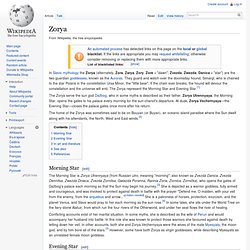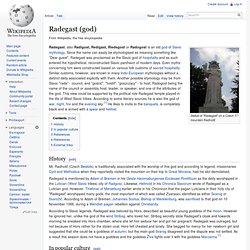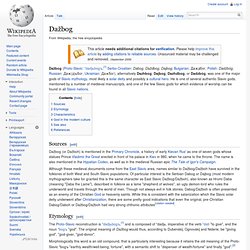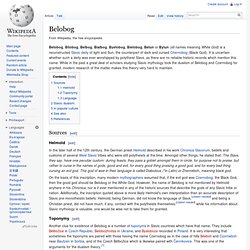

Zorya. The Zorya serve the sun god Dažbog, who in some myths is described as their father.

Zorya Utrennyaya, the Morning Star, opens the gates to his palace every morning for the sun-chariot's departure. At dusk, Zorya Vechernyaya—the Evening Star—closes the palace gates once more after his return. The home of the Zorya was sometimes said to be on Bouyan (or Buyan), an oceanic island paradise where the Sun dwelt along with his attendants, the North, West and East winds.[2] Morning Star[edit] Conflicting accounts exist of her marital situation. Evening Star[edit] In art and literature[edit] Zorya Vechernyaya is a sextet for oboe, bassoon and string quartet by Australian composer Julian Cochran.The Zorya appear in the multi-award-winning novel American Gods by English author Neil Gaiman. See also[edit] References[edit] Radegast (god) Statue of "Radegast" on a Czech mountain Radhošť Radegast, also Radigost, Redigast, Riedegost or Radogost is an old god of Slavic mythology.

Since the name can easily be etymologised as meaning something like “Dear guest”, Radegast was proclaimed as the Slavic god of hospitality and as such entered the hypothetical, reconstructed Slavic pantheon of modern days. Even myths concerning him were constructed based on various folk customs of sacred hospitality. Similar customs, however, are known in many Indo-European mythologies without a distinct deity associated explicitly with them.
Another possible etymology may be from Slavic "rada" - council, and "gościć", "hostit", "goszczący" - to host, Radogost being the name of the council or assembly host, leader, or speaker, and one of the attributes of the god. Mt. Radegast is mentioned by Adam of Bremen in his Gesta Hammaburgensis Ecclesiae Pontificum as the deity worshipped in the Lutician (West Slavic tribes) city of Radgosc. Hors. In Slavic mythology, Hors (Old Church Slavonic: Хърсъ, Cyrillic: Хорс) is the Slavic sun god.

The name Hors comes from the Iranian languages (Scythian or Sarmatian) — see Avestan: hvarə хšаētəm, Middle Persian: xvaršêt, Persian: xoršid (خورشید or خرشید) «Sun». According to the Russian Primary Chronicle, in 980, Vladimir I of Kiev «placed the idols at the hill outside the palace: wooden Perun… and Hors, Dažbog and Stribog and Simargl and Mokosh». Dažbog. Dažbog (Proto-Slavic: *dadjьbogъ,[1] Serbo-Croatian: Dabog, Daždbog, Dajbog; Bulgarian: Даждбог, Polish: Dadźbóg, Russian: Даж(д)ьбог, Ukrainian: Дажбог), alternatively Dazhbog, Dajbog, Dazhdbog, or Dadzbóg, was one of the major gods of Slavic mythology, most likely a solar deity and possibly a cultural hero.

He is one of several authentic Slavic gods, mentioned by a number of medieval manuscripts, and one of the few Slavic gods for which evidence of worship can be found in all Slavic nations. Sources[edit] Dažbog (or Dažboh) is mentioned in the Primary Chronicle, a history of early Kievan Rus' as one of seven gods whose statues Prince Vladimir the Great erected in front of his palace in Kiev in 980, when he came to the throne. The name is also mentioned in the Hypatian Codex, as well as in the medieval Russian epic The Tale of Igor's Campaign. Etymology[edit] Characteristics[edit] This is in fact a Slavic translation of an original Greek manuscript of Malalin from the 6th century. M. Belobog. Belobog, Bilobog, Belbog, Bialbog, Byelobog, Bielobog, Belun or Bylun (all names meaning White God) is a reconstructed Slavic deity of light and Sun, the counterpart of dark and cursed Chernobog (Black God).

It is uncertain whether such a deity was ever worshipped by polytheist Slavs, as there are no reliable historic records which mention this name. While in the past a great deal of scholars studying Slavic mythology took the dualism of Belobog and Czernobog for granted, modern research of the matter makes this theory very hard to maintain. Sources[edit] Helmold[edit] Slavic mythology. Many generations of Slavic artists were inspired by their national folklore: Ilya Yefimovich Repin, Sadko in the Underwater Kingdom (1876) Slavic mythology is the mythological aspect of the polytheistic religion that was practised by the Slavs before Christianisation.

The religion possesses many common traits with other religions descended from the Proto-Indo-European religion. Old Slavic religion evolved over more than a thousand years and some parts of it were from neolithic or possibly even mesolithic times. The Earth was worshipped as Mat Zemlya and there were no temples. Rituals were performed in nature.